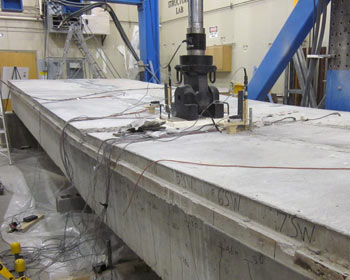Research Reports
Report Details
Abstract
 Precast prestressed double-tee girders are common on county bridges in South Dakota because of the ease of construction, short construction time, and low cost. However, the longitudinal joints of these bridges are rapidly deteriorating, imposing girder replacement after only 45 years of service. Currently, there are more than 700 double-tee bridges in South Dakota incorporating this joint detailing. The present study was conducted to develop, construct, and evaluate rehabilitation methods for this type of bridge. Current detailing between adjacent double-tee girders consists of discrete welded steel plate connections. A previous study showed that this detailing is insufficient for fatigue, service, and strength loads. Twenty joint rehabilitation detailing alternatives were proposed in the present study. Thirteen large-scale beams were tested to investigate the performance of the rehabilitation methods. Ultra-high performance concrete (UHPC) and latex modified concrete (LMC) were selected as the filler materials. Subsequently, two joint concepts, "pocket" and "continuous," were developed based on the experimental and analytical studies. A full-scale 40-ft-long double-tee bridge was constructed using conventional longitudinal joint detailing and then initially tested under fatigue loads. Subsequently, the bridge was rehabilitated using the two proposed details, pocket joint with UHPC and continuous joint with LMC, each incorporated on one-half of the bridge length. The rehabilitated specimen was tested under 600,000 cycles of AASHTO (American Association of State Highway and Transportation Officials) fatigue loads. Stiffness tests were performed to monitor the degradation of the bridge. Finally, the specimen was monotonically loaded to failure. No significant damage, beyond initial shrinkage cracks in LMC, was observed throughout the fatigue testing. Furthermore, the stiffness of the bridge did not degrade. No damage or yielding of the reinforcement in the joint was observed throughout the strength testing. The rehabilitated bridge met all AASHTO limit state requirements indicating sufficient performance. Overall, both proposed rehabilitation methods are structurally viable alternatives for double-tee bridge girders; however, only UHPC should be used as filler material at this time. The rehabilitation cost of a double-tee bridge with pocket detailing is expected to be only 30% of the bridge's superstructure replacement cost.
Precast prestressed double-tee girders are common on county bridges in South Dakota because of the ease of construction, short construction time, and low cost. However, the longitudinal joints of these bridges are rapidly deteriorating, imposing girder replacement after only 45 years of service. Currently, there are more than 700 double-tee bridges in South Dakota incorporating this joint detailing. The present study was conducted to develop, construct, and evaluate rehabilitation methods for this type of bridge. Current detailing between adjacent double-tee girders consists of discrete welded steel plate connections. A previous study showed that this detailing is insufficient for fatigue, service, and strength loads. Twenty joint rehabilitation detailing alternatives were proposed in the present study. Thirteen large-scale beams were tested to investigate the performance of the rehabilitation methods. Ultra-high performance concrete (UHPC) and latex modified concrete (LMC) were selected as the filler materials. Subsequently, two joint concepts, "pocket" and "continuous," were developed based on the experimental and analytical studies. A full-scale 40-ft-long double-tee bridge was constructed using conventional longitudinal joint detailing and then initially tested under fatigue loads. Subsequently, the bridge was rehabilitated using the two proposed details, pocket joint with UHPC and continuous joint with LMC, each incorporated on one-half of the bridge length. The rehabilitated specimen was tested under 600,000 cycles of AASHTO (American Association of State Highway and Transportation Officials) fatigue loads. Stiffness tests were performed to monitor the degradation of the bridge. Finally, the specimen was monotonically loaded to failure. No significant damage, beyond initial shrinkage cracks in LMC, was observed throughout the fatigue testing. Furthermore, the stiffness of the bridge did not degrade. No damage or yielding of the reinforcement in the joint was observed throughout the strength testing. The rehabilitated bridge met all AASHTO limit state requirements indicating sufficient performance. Overall, both proposed rehabilitation methods are structurally viable alternatives for double-tee bridge girders; however, only UHPC should be used as filler material at this time. The rehabilitation cost of a double-tee bridge with pocket detailing is expected to be only 30% of the bridge's superstructure replacement cost.
How to Cite
Bohn, Lucas, Mostafa Tazarv, and Nadim Wehbe. Rehabilitation of Longitudinal Joints in Double-Tee Girder Bridges, MPC-19-398. North Dakota State University - Upper Great Plains Transportation Institute, Fargo: Mountain-Plains Consortium, 2019.